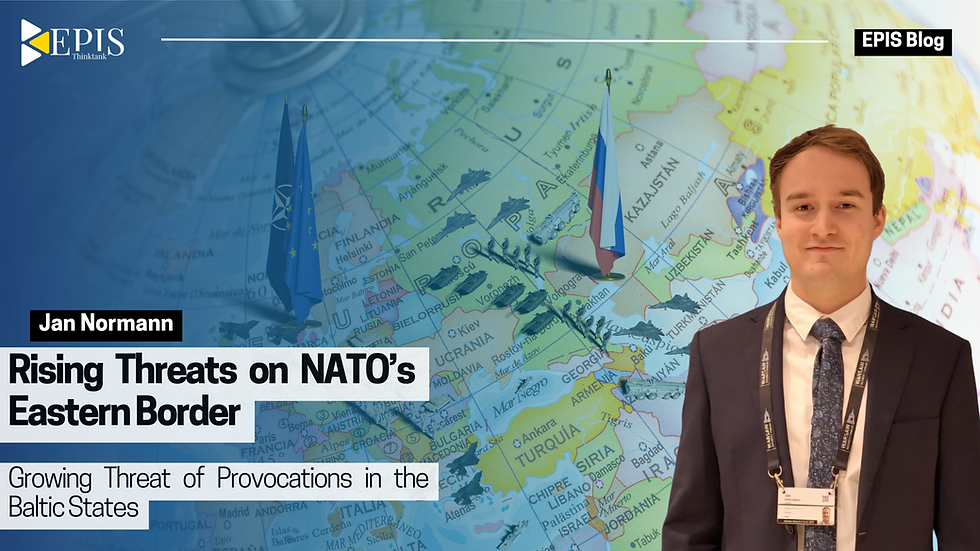Rising Threats on NATO’s Eastern Border: Growing Threat of Provocations in the Baltic States
- EPIS Think Tank

- 2 days ago
- 4 min read

On the night of 19th to 20th August 2025, a Russian drone decoy exploded just 130 km from Warsaw in the village of Osiny in Poland. This is undoubtedly another provocation by Russia in Poland since its aggression against Ukraine in 2022, and I believe it will certainly not be the last. However, this is not an isolated case; such incidents (including drones, rockets, sabotages) are taking place in many countries in the eastern part of NATO, including the Baltic States and Romania, causing growing concern and tension among the inhabitants of countries bordering the Russia–Ukraine war.
Growing threat of provocations in the Baltic States
In Estonia, on the 30th January 2024, two Moldovan men acting on behalf of the Russian Main Intelligence Directorate (GRU) carried out a trial operation by setting fire to a Co-op supermarket in the village of Osula, southeastern Estonia. The following day, the same individuals targeted the Slava Ukraina restaurant in Tallinn, the country’s capital. A few months later, in May 2024, Vilnius, the capital of Lithuania, witnessed another GRU-linked act of terrorism when an IKEA store was deliberately set on fire. In September 2024, a Russian drone crashed near the town of Rezekne in Latvia, likely having strayed from neighbouring Belarus. Fortunately, no one was injured, yet the incident raised concerns that the “stray drone” explanation would be insufficient if such a device were to hit a residential area. Taken together, these events highlight a growing threat – since 2022, acts of sabotage in the Baltic States have increased in frequency, and the threat continues to escalate.
From missiles to misinformation: Russia’s multi-layered threat to Romania
Romania is a country bordering Ukraine that has been affected by Russian aggression and where a series of events involving missiles and drones have taken place. To emphasise, Russian drone incursions into NATO airspace have become an increasingly serious concern for regional security. In 2023, On the night of September 3–4, a Russian Orlan-10 drone crashed in Romania’s Bistrița-Năsăud County, initially mistaken for a commercial drone before being confirmed as Russian military equipment. In the following days, fragments of other drones were discovered near the village of Plauru and between Nufăru and Victoria, close to a Romanian military unit, after Moscow’s strikes on Ukraine’s Danube ports. The Romanian Ministry of Defence later confirmed that drones had repeatedly crossed into national airspace during overnight attacks, prompting Romanian and German fighter jets to be scrambled to monitor the situation in Tulcea County. In 2024 on July 25, three Geran-2 drones entered Romanian territory and crashed, while on August 27 Latvia’s defence minister warned of a “concrete reaction” if Russian drones continued to cross into NATO territory. Together, these events highlight the growing risks of escalation along NATO’s eastern flank as Russia’s war against Ukraine spills over into Alliance territory. Moreover, it’s worth mentioning that Moscow weaponised some social media platforms e.g. TikTok – this topic was described very well in a blog article written by Antonia Laura Pup from the EPIS Think Tank.
On the front line of hybrid warfare: Poland’s struggle with Russian provocations
Since 2022, Poland has been one of the main countries affected by sabotage, ‘accidental’ missile and drone strikes, and since 2021, there has been a migration crisis on its eastern border, or as others call it, a hybrid war with Belarus, in which Lukashenko's regime uses people as weapons to exert pressure on the Polish border, and thus on the EU and NATO. As I mentioned at the beginning of this article – a Russian drone exploded on Tuesday night (19-20 August 2025). This incident raised concerns among Poles about what would happen if the drone flew in and killed someone, or what the line is between an ‘accidental’ drone and deliberate sabotage or an attack on a NATO country. However, this is just one of many examples. For instance, during the Russian missile attack on Ukraine, Polish radar detected an unidentified object, but nearby American F-15 fighter jets and Polish MiG-29s were unable to identify it before it disappeared. Several months later, on 27 April 2023, the remains of a Russian Kh-55 cruise missile were found near the city of Bydgoszcz, which had probably strayed off course and entered Polish territory during the attack on 16th December 2022 after flying through Belarusian airspace. The incident sparked political controversy over why the violation had not been disclosed earlier and how Polish air defences had lost sight of the missile.
Moreover, Poland is struggling with numerous acts of sabotage and cyberattacks. According to Lithuanian investigators, Russian intelligence is behind a series of arson attacks in Vilnius and Warsaw, where, among other things, a shopping centre was destroyed. On October 22, 2024, Polish Ministry of Foreign Affairs, Radosław Sikorski, said that “Russia is conducting hybrid warfare against Poland” and in response to these actions, Poland closed the Russian consulate in Poznań and expelled diplomats.
There is no denying that Russia’s aggression against Ukraine extends beyond its borders, destabilizing NATO’s entire eastern flank. Russia, together with its vassal Belarus, is carrying out acts of diversion and sabotage, provoking a crisis on the Polish-Belarusian border and testing NATO's reactions by regularly violating its airspace. I’m convinced that this is a planned strategy aimed at intimidating neighbouring countries, and such actions will be carried out continuously. Overall, the question is how NATO will respond to this and what can be done to deter Russia from carrying out such acts.



Comments